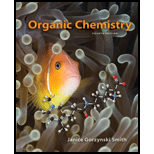
Concept explainers
(a)
Interpretation: The orbitals used to form each of the three indicated single bonds in Santalbic acid are to be found out. These σ bonds in order of increasing bond length is to be ranked.
Concept introduction:
Want to see the full answer?
Check out a sample textbook solution
Chapter 11 Solutions
Connect Access Card For Organic Chemistry
- Identify the orbitals on each of the atoms that form the bonds in H3CCN. How many bonds and bonds form?arrow_forwardTwo compounds have the same molecular formula C2H2Br2 one has a dipole moment the other does not both compounds react with bromine Br2 to produce the same compounds this reaction is a general accepted test for double bonds and each bromine atom of Br2 adds to a different atom of the double bond what is the identity of the original compounds dascribe the argument you usearrow_forwardTetrafluoroethylene, C2F4, is the starting material for the synthesis of the polymer poly tetrafluoroethylene (PTFE), one form of which is known as Teflon. Tetrafluoroethylene has a dipole moment of zero. Propose a structural formula for this molecule.arrow_forward
- Calculate the charge distribution and bond orders of 2,3-dimethyl butadiene.arrow_forwardConvert the following molecular formulas into line-bond structures that are consistent with valence rules: C3H8b) CH5Nc) C2H6O (2 possibilities)d) C3H7Br (2 possibilities)e) C2H4O (3 possibilities)f) C3H9N (4 possibilities)arrow_forwardDra the bond-line structure/formula for 3,3-diethylcyclodecyne.arrow_forward
 Chemistry: Principles and PracticeChemistryISBN:9780534420123Author:Daniel L. Reger, Scott R. Goode, David W. Ball, Edward MercerPublisher:Cengage Learning
Chemistry: Principles and PracticeChemistryISBN:9780534420123Author:Daniel L. Reger, Scott R. Goode, David W. Ball, Edward MercerPublisher:Cengage Learning Chemistry & Chemical ReactivityChemistryISBN:9781133949640Author:John C. Kotz, Paul M. Treichel, John Townsend, David TreichelPublisher:Cengage Learning
Chemistry & Chemical ReactivityChemistryISBN:9781133949640Author:John C. Kotz, Paul M. Treichel, John Townsend, David TreichelPublisher:Cengage Learning Chemistry & Chemical ReactivityChemistryISBN:9781337399074Author:John C. Kotz, Paul M. Treichel, John Townsend, David TreichelPublisher:Cengage Learning
Chemistry & Chemical ReactivityChemistryISBN:9781337399074Author:John C. Kotz, Paul M. Treichel, John Townsend, David TreichelPublisher:Cengage Learning Chemistry: The Molecular ScienceChemistryISBN:9781285199047Author:John W. Moore, Conrad L. StanitskiPublisher:Cengage Learning
Chemistry: The Molecular ScienceChemistryISBN:9781285199047Author:John W. Moore, Conrad L. StanitskiPublisher:Cengage Learning General Chemistry - Standalone book (MindTap Cour...ChemistryISBN:9781305580343Author:Steven D. Gammon, Ebbing, Darrell Ebbing, Steven D., Darrell; Gammon, Darrell Ebbing; Steven D. Gammon, Darrell D.; Gammon, Ebbing; Steven D. Gammon; DarrellPublisher:Cengage Learning
General Chemistry - Standalone book (MindTap Cour...ChemistryISBN:9781305580343Author:Steven D. Gammon, Ebbing, Darrell Ebbing, Steven D., Darrell; Gammon, Darrell Ebbing; Steven D. Gammon, Darrell D.; Gammon, Ebbing; Steven D. Gammon; DarrellPublisher:Cengage Learning




